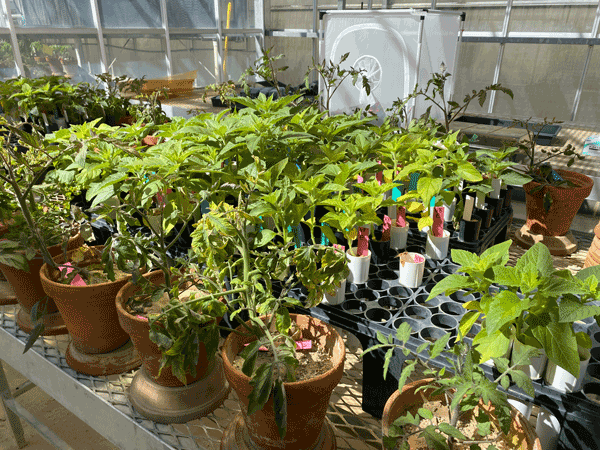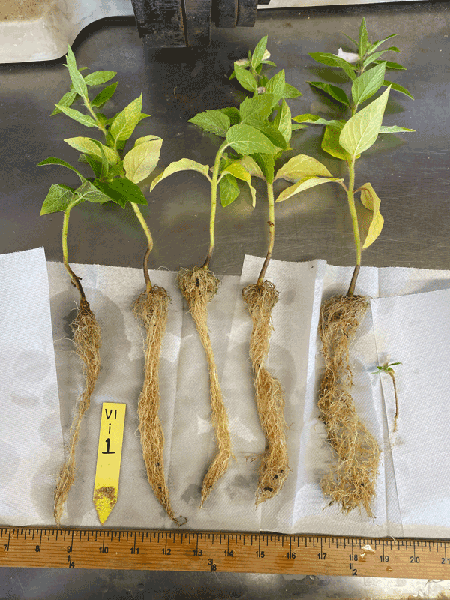Introduction
Sesame (Sesamum indicum L.) is an annual warm-season oilseed crop commonly grown in Africa and Asia. Acres of sesame in the United States continue to grow as demand outweighs domestic production. Texas and Oklahoma produce the majority of the nation’s crop. Of the 55,178 acres harvested in the US in 2017, 52,558 acres came from these two states (USDA NASS 2019). Recent work, funded by the North Carolina Department of Agriculture’s New and Emerging Crops Program, investigated the feasibility of sesame production in North Carolina. Sesame has the potential to add numerous benefits to our state’s broad acreage crop rotations. Often referred to as a “survivor crop,” sesame is one of the most drought tolerant oilseed crops. Sesame requires relatively low fertilizer and has shown resistance to certain root-knot nematode (RKN) species (Dossa et al. 2016; McSorley 1999).
Root-knot nematodes are microscopic soil-borne roundworms that cause losses of yield in many North Carolina crops such as soybean, corn, sweet potato, and cotton. There are several specific species within the broad category of root-knot nematodes, each with their preferred host plants and ranges. Common RKN species in North Carolina include Meloidogyne incognita (Southern RKN), Meloidogyne arenaria (peanut RKN), Meloidogyne hapla (Northern RKN), and Meloidogyne javanica (Javanese RKN). Recently, an invasive species called Meloidogyne enterolobii (guava RKN) has raised concern because of its highly virulent status, very broad host range, and severe symptoms that it produces in many crops.
Greenhouse Trials
We conducted greenhouse trials to screen seven commercially available sesame varieties (Table 1) for resistance to our state’s most common RKN species: M. arenaria, M. hapla, M. incognita, and M. enterolobii. We included an RKN susceptible tomato (cultivar ‘Rutgers’) as our control (Figure 1).
Table 1. Sesame variety investigated in greenhouse trials.
| Variety | Company of Origin |
|---|---|
| 3 | Equinom |
| 7 | Equinom |
| 8 | Equinom |
| S39 | Sesaco |
| S3276 | Sesaco |
| 3251 | Sesaco |
| SS3301 | Sesaco |
The sesame varieties and tomato controls were planted in containers filled with a 1:1 sand to soil mixture. Thirty days after germination, we inoculated each container with 1,000 RKN eggs. Sixty days after inoculation, the roots were harvested from the containers, washed thoroughly (see Figure 2), and processed to extract the nematode eggs. We observed the roots of the tomato plant and noted the presence of galls, as shown in Figure 3. Galls are abnormal knot-like swellings along plant roots that provide nutrients for the nematode infection, which invade the plant’s root system.
We then divided the final egg count by the initial amount of eggs used to inoculate (1,000) in order to calculate the reproductive factor (RF). Reproductive factor values are frequently used to determine the susceptibility or resistance of a plant species to nematodes. An RF value less than one indicates a poor host or non-host resistance, while values above one indicate susceptibility (Ferris et al. 1993). An RF value equal to one indicates a maintenance host, in which the population of nematodes is neither increasing nor decreasing.
Results
We found significant differences in RF values between the tomato control and sesame varieties for all nematode species except M. arenaria (see Table 2). Although numerically different, the degree of variability observed in the RF values for the M. arenaria inoculated plants was too great to find significant differences at the 95% confidence interval (p > 0.05). For plants inoculated with M. incognita and M. hapla, the trend was clear: the RF values among the sesame varieties were similar and all were significantly lower than the tomato control. Sesame appears to have very strong resistance to M. incognita across varieties, with RF values no greater than 0.23 compared to 27.50 in the tomato control. We can also think of RF values as a percent change in the number of nematode eggs following inoculation and growth. For example, the RF for the tomato control inoculated with M. incognita (27.50) represents a 2,750% increase in the number of eggs. Conversely, the sesame Variety 3 inoculated with M. incognita (RF = 0.04) showed a 96% decrease in eggs.
The results from inoculation with M. enterolobii were similar to M. hapla and M. incognita in that the reproductive factors of all the sesame varieties were significantly lower than the tomato control. However, we found significant differences among the sesame varieties inoculated with M. enterolobii. Variety S39 had the highest RF (1.63), and thus would not be considered resistant to this nematode species. Although varieties S3276 (RF = 0.71) and 3251 (RF = 0.75) were below 1, they were not significantly different from variety S39, which indicated that we cannot confidently conclude that they are truly resistant to M. enterolobii. Varieties 3 (RF = 0.15) and 8 (RF = 0.16) showed strong resistance to M. enterolobii. The differences observed among sesame varieties for M. enterolobii may indicate genetic differences present in the crop for resistance to this pathogen.
Table 2. Reproductive factor for sesame varieties inoculated with four species of root-knot nematodes.
| Variety | Reproductive Factor | |||
|---|---|---|---|---|
| M. arenaria | M. enterolobii | M. hapla | M. incognita | |
|
3 |
0.68 |
0.15 d |
0.12 b |
0.04 b |
|
7 |
0.31 |
0.47 cd |
1.05 b |
0.03 b |
|
8 |
0.81 |
0.16 cd |
0.07 b |
0.13 b |
|
S39 |
1.13 |
1.63 b |
0.18 b |
0.04 b |
|
S3276 |
1.28 |
0.71 bc |
0.69 b |
0.08 b |
|
3251 |
0.44 |
0.75 bc |
0.04 b |
0.20 b |
|
SS3301 |
1.01 |
0.43 cd |
0.12 b |
0.23 b |
|
Tomato control |
3.96 |
6.74 az |
3.72 a |
27.50 a |
|
p-value |
0.0649 |
<0.0001 |
<0.0001 |
<0.0001 |
z Means sharing the same letter within a nematode species are not significantly different (p > 0.05).
The results from these greenhouse trials indicate that specific sesame varieties have strong resistance to M. incognita, M. enterolobii, and M. hapla. The observed resistance to M. enterolobii is particularly promising because this species has a broad host range and is highly virulent (Schwarz et al. 2020). Further work is needed to determine if these results translate to fields with known RKN infestation. If the resistance holds true in the field, sesame may play a critical role in crop rotations for conventional and organic producers who are managing these damaging pests. Incorporating nematode resistant crops within traditional crop rotations has the potential to reduce nematode populations. In heavily infested fields, sesame may offer farmers the ability to start managing nematodes, while also producing a cash crop on land that may otherwise be left fallow.
Literature
Ferris, H., H.L. Carlson, D.R. Viglierchio, B.B. Westerdahl, F.W. Wu, C.E. Anderson, A. Juurma, and D.W. Kirby. 1993. “Host Status of Selected Crops to Meloidogyne Chitwoodi.” Supplement to the Journal of Nematology 25, no.4S: 849-857.
Dossa, Komivi, Diaga Diouf, and Ndiaga Cissé. 2016. “Genome-Wide Investigation of HSF Genes in Sesame Reveals Their Segmental Duplication Expansion and Their Active Role In Drought Stress Response.” Frontiers in Plant Science, 7: 1522.
McSorley, R. 1999. “Host Suitability of Potential Cover Crops for Root-Knot Nematodes.” Journal of Nematology, 31, no. 4S: 619-623.
United States Department of Agriculture, National Agricultural Statistics Service. 2019. 2017 Census of Agriculture. Washington, DC: US Department of Agriculture.
Schwarz, Tanner, Chunying Li, Weiman Ye, and Eric Davis. 2020. “Distribution of Meloidogyne Enterolobii in Eastern North Carolina and Comparison of Four Isolates.” Plant Health Progress 21, no. 2: 91–96.
Zeck, W. M. 1971. “A Rating Scheme for Field Evaluation of Root-Knot Nematode Infestations.” Pflanzenschutz-Nachrichten Bayer AG 24, no.1: 141–144.
Acknowledgement
This work was generously supported by the North Carolina Department of Agriculture & Consumer Services New and Emerging Crops Program.
Publication date: July 18, 2022
AG-936
N.C. Cooperative Extension prohibits discrimination and harassment regardless of age, color, disability, family and marital status, gender identity, national origin, political beliefs, race, religion, sex (including pregnancy), sexual orientation and veteran status.



